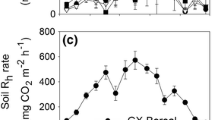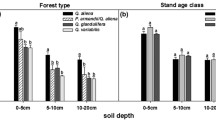Abstract
Eight forest sites representing a large range of climate, vegetation, and productivity were sampled in a transect across Oregon to study the relationships between aboveground stand characteristics and soil microbial properties. These sites had a range in leaf area index of 0.6 to 16 m2 m−2 and net primary productivity of 0.3 to 14 Mg ha−1 yr−1.
Measurements of soil and forest floor inorganic N concentrations and in situ net N mineralization, nitrification, denitrification, and soil respiration were made monthly for one year. Microbial biomass C and anaerobic N mineralization, an index of N availability, were also measured. Annual mean concentrations of NH +4 ranged from 37 to 96 mg N kg−1 in the forest floor and from 1.7 to 10.7 mg N kg−1 in the mineral soil. Concentrations of NO −3 were low ( < 1 mg N kg−1) at all sites. Net N mineralization and nitrification, as measured by the buried bag technique, were low on most sites and denitrification was not detected at any site. Available N varied from 17 to 101 mg N kg−1, microbial biomass C ranged from 190 to 1230 mg Ckg−1, and soil respiration rates varied from 1.3 to 49 mg C kg−1 day−1 across these sites. Seasonal peaks in NH +4 concentrations and soil respiration rates were usually observed in the spring and fall.
The soils data were positively correlated with several aboveground variables, including leaf area index and net primary productivity, and the near infrared-to-red reflectance ratio obtained from the airborne simulator of the Thematic Mapper satellite. The data suggest that close relationships between aboveground productivity and soil microbial processes exist in forests approaching semi-equilibrium conditions.
Similar content being viewed by others
Abbreviations
- IR:
-
infrared
- LAI:
-
leaf area index
- k c :
-
proportion of microbial biomass C mineralized to CO2
- NPP:
-
net primary productivity
- TM:
-
Thematic Mapper
References
Ågren GI (1983) Nitrogen productivity of some conifers. Can. J. For. Res. 13: 494–500
Anderson JPE & Domsch KH (1978) Mineralization of bacteria and fungi in chloroformfumigated soils. Soil Biol. Biochem. 10: 207–213
Birk EM & Vitousek PM (1986) Nitrogen availability and nitrogen use efficiency in lobolly pine. Ecology 67: 69–79
Brix H (1971) Effects of nitrogen fertilization on photosynthesis and respiration in Douglas-fir. For. Sci. 17: 407–414
Davidson EA, Groffman PM & Myrold DD (1989) Denitrification in temperate forest ecosystems. In: Gessel S (Ed) Sustained Productivity of Forest Lands (in press)
Ewel KC, Cropper WP, Jr. & Gholz HL (1987) Soil CO2 evolution in Florida slash pine plantations. I. Changes through time. Can. J. For. Res. 17: 325–329
Gholz HL (1982) Environmental limits on aboveground net primary production, leaf area, and biomass in vegetation zones of the Pacific Northwest. Ecology 63: 469–481
Gordon AM, Schlentner RE & Van Cleve K (1987) Seasonal patterns of soil respiration and CO2 evolution following harvesting in the white spruce forests of interior Alaska. Can. J. For. Res. 17: 304–310
Gosz JR (1981) Nitrogen cycling in coniferous ecosystems. In: Clark FE & Rosswall T (Eds) Terrestrial Nitrogen Cycles (pp 405–426) Swed. Nat. Sci. Res. Counc., Stockholm
Gosz JR & White CS (1986) Seasonal and annual variation in nitrogen mineralization and nitrification along an elevational gradient in New Mexico. Biogeochem. 2: 281–297
Groffman PM & Tiedje JM (1989) Dentrification in north temperate forest soils. II. Relationship between denitrification and environmental parameters at the landscape scale. Soil Biol. Biochem. (in press)
Jenkinson DS & Powlson DS (1976) The effects of biocidal treatments on metabolism in soil. V. A method for measuring soil biomass. Soil Biol. Biochem. 8: 209–213
Keeney DR & Bremner JM (1966) Comparison and evaluation of laboratory methods of obtaining an index of soil nitrogen availability. Agron. J. 58: 498–503
Li X & Strahler AH (1985) Geometric-optical modelling of a conifer forest canopy. IEEE Trans. Geosci. Remote Sens. 23: 705–721
Matson PA & Harriss RC (1988) Aircraft-based measurements of biosphere-atmosphere gas exchange. Ecology 69: 1318–1325
Mooney HA, Vitousek PM & Matson PA (1987) Exchange of materials between terrestrial ecosystems and the atmosphere. Science 238: 926–932
Myrold DD (1987) Relationship between microbial biomass nitrogen and a nitrogen availability index. Soil Sci. Soc. Am. J. 51: 1047–1049
Parkin TB (1985) Automated analysis of nitrous oxide. Soil Sci. Soc. Am. J. 49: 273–276
Parkin TB, Kaspar HF, Sexstone AJ & Tiedje JM (1984) A gas-flow soil core method to measure field denitrification rates. Soil Biol. Biochem. 16: 323–330
Pastor J, Aber JD, McClaugherty CA & Melillo JM (1984) Aboveground production and N and P cycling along a nitrogen mineralization gradient on Blackhawk Island, Wisconsin. Ecology 65: 256–268
Peterson DL, Spanner MA, Running SW & Teuber KB (1987) Relationship of Thematic Mapper simulator data to leaf area index of temperate coniferous forests. Remote Sens. Environ. 22: 323–341
Powers RF (1980) Mineralizable soil nitrogen as an index of nitrogen availability to forest trees. Soil Sci. Soc. Am. J. 44: 1314–1320
Reiners WA (1968) Carbon dioxide evolution from the floor of three Minnesota forests. Ecology 49: 471–483
Robertson GP & Tiedje JM (1984) Denitrification and nitrous oxide production in successional and old-growth Michegan forests. Soil Sci. Soc. Am. J. 48: 383–389
Running SW, Peterson DL, Spanner MA & Teuber KB (1986) Remote sensing of coniferous forest leaf area. Ecology 67: 273–276
Schlentner RE & Van Cleve K (1985) Relationships between CO, evolution from soil, substrate temperature, and substrate moisture in four mature forest types in interior Alaska. Can. J. For. Res. 15: 97–106
Schlesinger WH (1977) Carbon balance in terrestrial detritus. Ann. Rev. Ecol. Syst. 8: 51–81
Shumway JS & Atkinson WA (1978) Predicting nitrogen fertilizer response in unthinned stands of Douglas-fir. Commun. Soil Sci. Plant Anal. 9: 529–539
Tucker CJ, Fung IY, Keeling CD & Gammon RH (1986) Relationship between atmospheric CO2 variations and a satellite-derived vegetation index. Nature 319: 195–199
Vitousek PM (1982) Nutrient cycling and nutrient use efficiency. Am. Nat. 119: 553–572
Vitousek PM, Fahey T, Johnson DW & Swift MJ (1988) Element interactions in forest ecosystems: succession, allometry, and input-output budgets. Biogeochem. 5: 7–34
Vitousek PM, Gosz JR, Grier CC, Melillo JM & Reiners WA (1982) A comparative analysis of potential nitrification and nitrate mobility in forest ecosystems Ecol. Monogr. 52: 155–177
Vitousek PM & Matson PA (1985) Disturbance, nitrogen availability, and nitrogen losses in an intensively managed loblolly pine plantation. Ecology 66: 1360–1376
Vogt, DJ & Edmonds RL (1982) Nitrate and ammonium levels in relation to site quality in Douglas-fir soil and litter. Northwest Sci. 56: 83–89
Vogt KA, Edmonds RL, Antos GC & Vogt DJ (1980) Relationships between CO2 evolution, ATP concentrations and decomposition in four forest ecosystems in western Washington. Oikos 35: 72–79
Vogt KA, Grier CC & Vogt DJ (1986) Production, turnover, and nutrient dynamics of above and belowground detritus of world forests. Adv. Ecol. Res. 15: 303–377
Vogt KA, Vogt DJ, Moore EE, Fatuga BA, Redlin MR & Edmonds RL (1987) Conifer and angiosperm fine-root biomass in relation to stand age and site productivity in Douglas-fir forests. J. Ecol. 75: 857–870
Waring RH (1983) Estimating forest growth efficiency in relation to canopy leaf area. Adv. Ecol. Res. 13: 327–354
Weber MG (1985) Forest soil respiration in eastern Ontario jack pine ecosystems. Can. J. For. Res. 15: 1069–1073
Wissmar RC, Richey JE, Devol AH & Eggers DM (1982) Lake ecosystems of the Lake Washington Drainage Basin. In: Edmonds RL (Eds) Analysis of Coniferous Forest Ecosystems in the Western United States (pp. 333–385) Hutchinson Ross Publishing Co., Stroudsburt, PA
Yoshinari T & Knowles (1976) Acetylene inhibition of nitrous oxide reduction by denitrifying bacteria. Biochem. Biophys. Res. Commun. 69: 705–710
Author information
Authors and Affiliations
Rights and permissions
About this article
Cite this article
Myrold, D.D., Matson, P.A. & Peterson, D.L. Relationships between soil microbial properties and aboveground stand characteristics of conifer forests in Oregon. Biogeochemistry 8, 265–281 (1989). https://doi.org/10.1007/BF00002892
Issue Date:
DOI: https://doi.org/10.1007/BF00002892




